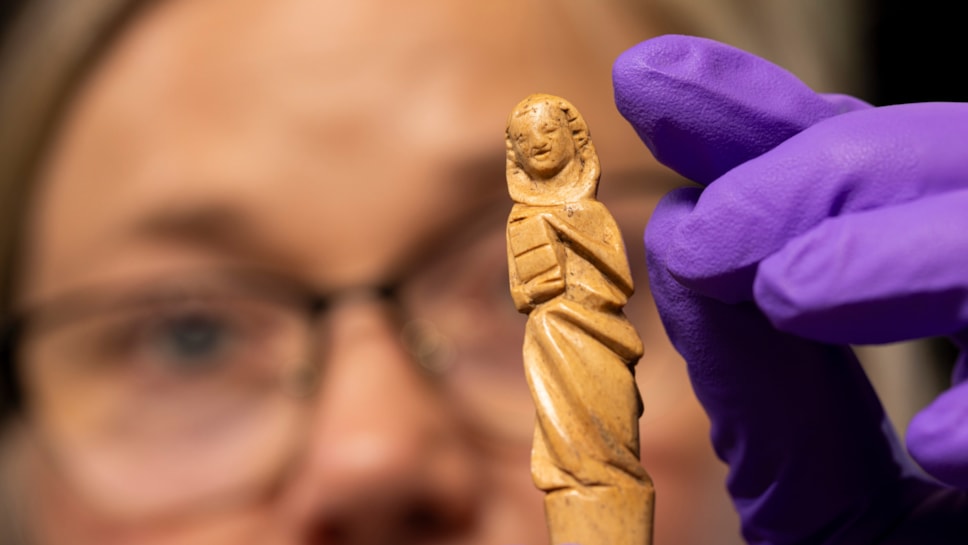
Evidence for medieval hair styling at the iconic Eilean Donan castle is revealed as rich archaeological assemblage is acquired for the nation
A rare 13th century tool used for styling hair has been acquired by National Museums Scotland after being discovered during archaeological excavations at one of the country's most famous castles.
Press images are available here.
The ‘gravoir’ was found during a research-led programme of excavation at Eilean Donan castle in the Highlands. One of the most popular visitor attractions in Scotland, the castle is an iconic image of Scotland recognised around the world, however very little was known about its medieval heyday until these excavations were carried out by FAS Heritage. Positioned at the gateway to Skye, it has appeared in films including Highlander and The World is not Enough.
Inspired by medieval fashions in France, the gravoir would have been used to part hair precisely and create elaborate styles. Carved from local red deer antler and featuring a figure wearing a hood and holding a book, it is one of only three examples from the UK, and the first to be found in Scotland. Gravoirs are generally made from ivory, however this one is an unusual example of a European-style object realised in local materials.
The gravoir is one of the highlight objects from an assemblage of archaeological material from Eilean Donan which has been acquired by National Museums Scotland. Dating to the 13th and 14th centuries, finds associated with feasting, music, hunting, gaming and seafaring reveal stories about medieval life at what was a powerful centre of Highland Gaelic culture, strategically built at the meeting of three great sea lochs.
Objects including brooches and dress pins were excavated alongside animal bones and crucibles – small ceramic cups used to melt copper alloy, silver and gold. Traces of precious metals found in them suggest that jewellery and personal dress items were being made at the castle.
These form part of what is one of the most important collections of medieval metalworking in the UK, revealing how everything from buckles to swords were manufactured on site. Filling some 80 boxes at the National Museums Collection Centre in Granton, the assemblage will now be a rich resource for researchers.
The assemblage also offers a glimpse into how castle inhabitants spent their leisure time. It includes game pieces made from decorated bone and recycled pottery and an iron jaw harp - a musical instrument placed in the mouth and plucked to make a distinctive sound. Animal bones with holes drilled through them would have been strung onto a leather thong, twisted up and released to make a buzzing noise. Known as ‘buzz bones’ they might have been used by children as toys.
Dr Alice Blackwell, Senior Curator of Medieval Archaeology and History at National Museums Scotland said:
“This remarkable gravoir shows us how elite inhabitants of Eilean Donan were engaging with fashions on the continent. However the assemblage reveals a much broader picture of life in the 13th and 14th centuries. It allows us to imagine how the full social spectrum of people inside the castle walls spent their days, whether styling their hair, toiling in a smithy or making simple toys for children to play with. It’s a privileged glimpse into life in medieval Scotland that we don’t often get.”
After its heyday as a centre of medieval Gaelic lordship in the 13th to 15th centuries, the importance of Eilean Donan declined. By 1650, it seems to have been poorly maintained and by 1714 it was recorded as roofless and derelict. In 1719 it was used by Jacobite forces as a supply depot, and as a consequence was bombarded by British warships. It was eventually captured by British troops and blown up to prevent it being used again by Jacobite supporters. It stayed a ruin until an ambitious rebuilding campaign in the early 20th century transformed Eilean Donan into the castle we know today.
Miranda van Lynden, Head Trustee at The Conchra Charitable Trust which owns Eilean Donan Castle said:
“Eilean Donan represents the very essence of a Scottish castle and its image is recognised around the world. However we knew surprisingly little about life in the castle at the height of its power and influence in the 13th and 14th centuries. We commissioned these excavations to reveal some of these stories. We’re pleased that this assemblage can now be researched further, and we hope it will introduce the rich history of Eilean Donan to new audiences.”
Notes to editors
National Museums Scotland is one of the leading museum groups in the UK and Europe and it looks after collections of national and international importance. The organisation provides loans, partnerships, research and training in Scotland and internationally. Our individual museums are the National Museum of Scotland, the National Museum of Flight, the National Museum of Rural Life and the National War Museum. The National Museums Collection Centre in Edinburgh houses conservation and research facilities as well as collections not currently on display.
Facebook: www.facebook.com/NationalMuseumsScotland
Instagram: @NationalMuseumsScotland
Bheireadh Oifis nam Meadhanan eadar-theangachadh Gàidhlig den bhrath-naidheachd seachad do bhuidhinn mheadhanan bharantaichte. Cuiribh fios do dh'Oifis nam Meadhanan airson bruidhinn air cinn-latha freagarrach.
